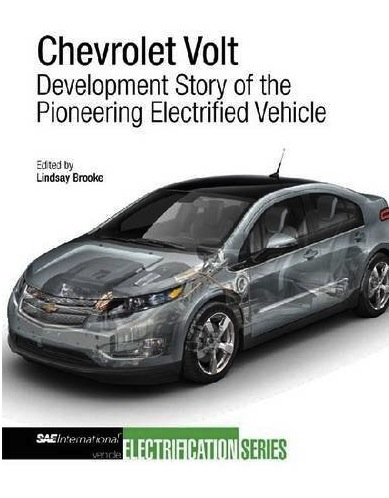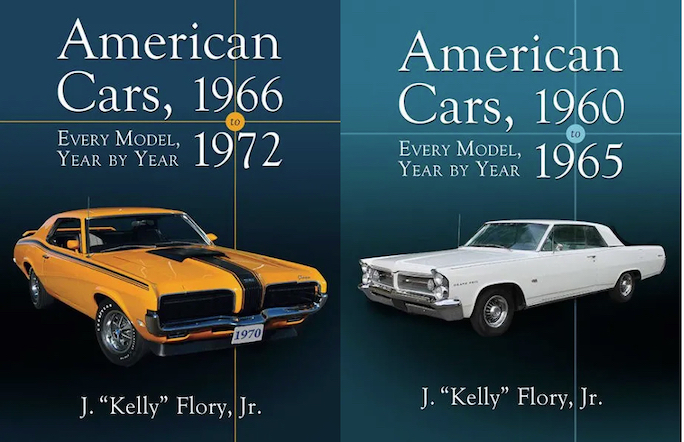Chevrolet Volt: Development Story of the Pioneering Electrified Vehicle
 Lindsay Brooke (Editor)
Lindsay Brooke (Editor)
This book gathers together 14 SAE engineering technical papers and 10 magazine articles about the development of the Chevrolet Volt extended range electric vehicle. This mixing of technical reprints and magazine articles makes the book a bit of a hybrid itself—not a pure technical journal, not a pure consumer publication. I would expect the brains of non-engineering general readers to glaze over a bit while wading through the technical papers, then spark back to life during the colorful and well-written magazine sections.
Roughly 65% of the book is made up of technical papers, however, so put on your smart cap and get ready to focus mentally. If you actually are an engineer, then expect to find this compendium a fun read. It will appeal to engineers who want a technical summary that justifies the Volt’s final design configuration, and fills in how the mechanical and electrical systems interface, working together to produce a potentially paradigm-shifting consumer vehicle.
If you want to know, in engineering terms, what makes the Volt a viable commercial venture, then this book is an excellent starting point. If you want the human side of the development story, then you’ll have to make do with the occasional flashes of humanity that peek through here and there in the interspersed magazine articles. Brooke, who put this compendium together, is the senior editor of SAE’s Automotive Engineering International magazine. He also knows how to write, as evidenced by his numerous popular magazine and newspaper articles. He has also written four books on the history of Triumph motorcycles and the Ford Model T, and won an award for his writing along the way. The technical papers, however, are beyond his editorial purview. The bad grammar and awkwardly worded cadence found in these papers frequently brings a certain linguistic humor to an otherwise unemotional technical presentation. A typical example of a sentence crying out for grammatical help: “These vehicles has coast down parameter.” My favorite complete sentence that is not actually a sentence is, “This epoxy while providesing an additional insulation coating.” These examples perhaps show us what to expect to happen to language and literature if engineers actually do take over the world.
Now and then the material in the magazine articles seems too heavily based on GM promotional releases, and a couple of the technical reprints seem to be included simply to fill space. Twelve pages on how to start a gas engine automatically without adversely affecting driver’s seat pk-pk vibrations is a bit more than I wanted to know, particularly as no mention is made in the technical paper of any of this material being directly applied to the Volt. The same lack of real relevance to how the Volt operates reappears in the technical paper on the numerous computer-aided design iterations of the Volt’s battery tray. Interesting as an example of how modal performance assessment can be used to design a metal stamping, but beyond that, a bit vague as to its relevance to the truly electrifying technology that makes up the Volt.
On the bright side, the book is full of very good color photography and interesting cutaway ghost photos and computer-generated images of parts. I would consider it a must-buy for anyone actively involved in the shift toward electric vehicles, and an interesting read for those curious about where the transportation industry is headed generally.
In more ways than one this book illustrates how the auto industry has one foot on the dock and the other in the boat as far as the design transition from mechanical to electrical vehicles is concerned. The car industry is no longer where it was, but not yet where it’s going to be. An interesting time period indeed, both for the manufacturers and the supply base. The technical papers indicate that new ideas and designs are expected from the supply base, and that future orders for parts will shift toward “the companies that step out and harness money and intellectual commitment.” Sounds like a warning to Tier 1 suppliers that the winds of change are beginning to blow through an old school industry, and excellent past performance in a mechanical age is no longer enough to guarantee future participation in an industry trending toward electric propulsion.
The book is composed of a Table of Contents, Preface, and 10 Chapters covering battery design, “A Unique Electrified Transaxle,” “Charging and Connectivity,” the development of high-mileage tires, aerodynamic development of the body shape, and other related topics. No index.
Copyright 2012, Bill Ingalls (speedreaders.info).


 RSS Feed - Comments
RSS Feed - Comments





































































 Phone / Mail / Email
Phone / Mail / Email RSS Feed
RSS Feed Facebook
Facebook Twitter
Twitter